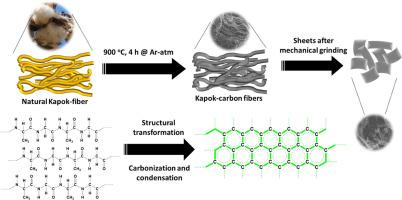作为可持续电极材料的天然木棉纤维二维碳化片
IF 3.1
Q2 MATERIALS SCIENCE, MULTIDISCIPLINARY
引用次数: 0
摘要
源自天然生物质的碳纳米结构因其独特的表面和电化学特性而备受研究关注。本研究体现了从低成本天然来源木棉蚕丝纤维中提取的碳化微纳米片。该材料通过简便的热解工艺获得。衍射分析显示了一个宽广的类似石墨烯结构的峰值,表明形成了类似石墨烯的碳纳米片。场发射扫描电子显微镜(FESEM)和透射电子显微镜(TEM)图像证实了碎碳片的存在,其中一些被折叠形成管状结构。拉曼研究显示存在 D 和 G 波段,Id/Ig 比为 0.96,这表明形成了少层碳纳米片。此外,还对锂离子电池和超级电容器的电化学性能进行了评估。在 0.1 C 速率下,锂离子电池的比容量为 465 mAh.g-1,超级电容器的比电容为 473.61 F.g-1,电容保持率为 95%。这项研究为储能系统中天然纤维基碳的可持续生产和利用战略提供了启示。本文章由计算机程序翻译,如有差异,请以英文原文为准。

Natural Kapok fiber-derived two-dimensional carbonized sheets as sustainable electrode material
Natural biomass-derived carbon nanostructures have attracted research interest because of their unique surface and electrochemical properties. The present study embodied the carbonized micro-nano sheets derived from the low-cost natural source Kapok silk fiber. The material was obtained via a facile thermal pyrolysis process. Diffraction analysis showed a broad graphene structure-like peak, indicating the formation of graphene-like carbon nanosheets. Field emission scanning electron microscope (FESEM) and transmission electron microscopic (TEM) images confirmed the presence of fragmented carbon sheets, some of which were folded to form a tube-like structure. Raman study showed the presence of D and G band with the Id/Ig ratio of 0.96 which indicated the formation of few-layered carbon nanosheets. Furthermore, the electrochemical performance was evaluated for lithium-ion battery as well as supercapacitor. A specific capacity of 465 mAh.g-1 at 0.1 C rate for Li-ion battery and a specific capacitance of 473.61 F.g-1 for supercapacitor have been obtained with the capacitance retention of 95 %. This study provides insights into a strategy for the sustainable production and utilization of natural fiber-based carbon in energy storage systems.
求助全文
通过发布文献求助,成功后即可免费获取论文全文。
去求助
来源期刊

Carbon Trends
Materials Science-Materials Science (miscellaneous)
CiteScore
4.60
自引率
0.00%
发文量
88
审稿时长
77 days
 求助内容:
求助内容: 应助结果提醒方式:
应助结果提醒方式:


